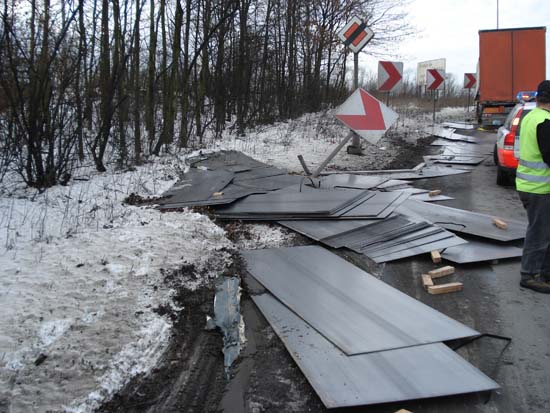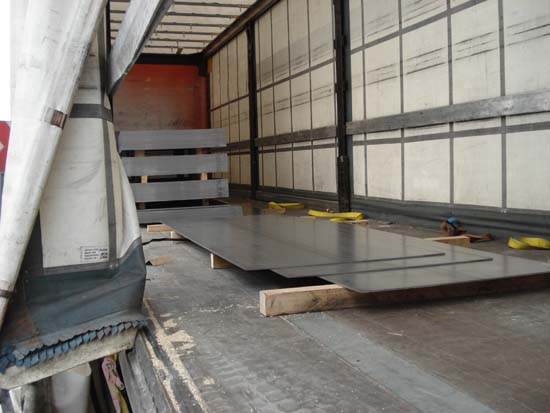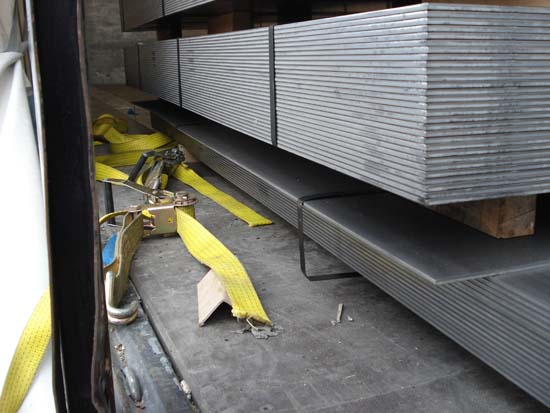Heavy-metal
The transport industry frequently appears to suffer from a communication breakdown between the load and vehicle on which it is being transported. In the case in hand, the vehicle failed to inform the load of a bend to the right in good time. Unsurprisingly, the load continued straight on. Since communication between the load and the loading area is a matter of physics, it would be worth having a look at the loading area to find out where the communication problems arose.

Figure 1 [R. Lausberg]
But before we have a closer look at the loading area, let us analyze the damage that we see. And it does, indeed, appear that the load has continued traveling straight on. Because the load was not adequately secured, it was not able to stay with the vehicle round the bend and was thrown in the original direction, i.e. a tangent to the arc of the bend. It appears that the load was bundled together only unilateral direction. And, from what we can see of the damage, there seem to have been several packages.

Figure 2 [R. Lausberg]
The trailer (a curtainsider) was indeed loaded with two stacks, each containing four packages of sheet steel. The load was secured with two tie-down lashings over each stack of sheet metal. The weight of the load was approximately 26,000 kg.

Figure 3 [R. Lausberg]
It is clear to see that, despite all the other inadequacies in the load securing, the inadequate packaging and missing longitudinal strapping had a huge influence on the securing of this load. Despite the lateral strapping, the contents of packages have started to slip internally. Looking at it from our perspective, we are unable to assess the friction. It is possible that the sheet metal had been coated with oil to prevent corrosion. If this was the case, the strapping would have played an even more crucial role. We can also clearly see that the belts were cut through by the sharp edges when the sheet metal slipped as if they had been cut with a knife.
Confronted with this foolishness and the complete lack of thought that went into this load, it is certainly difficult to look at the inadequacies of this load in respect of packaging, the formation of load units and the securing of the load and still remain objective.
 |
Packaging |
|
Because fit-for-use packaging is the starting point for safe transportation, we shall begin by assessing the packaging of these metal sheets. The packaging itself consisted solely of the lateral strapping of these metal sheets to form bundles. Because steel sheets quite naturally have the tendency to also slip longitudinally, it would have been thoroughly appropriate and sensible to strap the load longitudinally with steel straps as well. But it is also possible to overcome this lack of packaging by placing pallets or squared lumber on edge behind and in front of the stacks and then securing these lumber elements with head loops and loop lashings.
|
|
When our gentle practitioners see loose lumber placed beneath the load, they may well be filled with fear and trepidation, because handling loose lumber is not only impractical, but also unnecessarily complicates the use of anti-slip materials. If lateral dunnage is used, it is desirable that the dunnage should have a groove to accommodate the steel bands, and that the dunnage should preferably be rectangular in section (but more of that later). This would ensure that the wooden dunnage is securely connected to the packages of sheet metal and that the sheet metal is effectively protected against stresses caused by handling with ground conveyors, which might cause considerable damage to it.
|
 |
Stacking |
|
It is particularly noteworthy that two different types of squared lumber appear to have been used when stacking the load. Three pieces of squared lumber with a square cross-section were placed laterally under the bottom layer of the load. In this column we have often pointed out that square cross-sections have a tendency to roll and that it is better and wiser to use dunnage with a rectangular cross section.
|
|
The interlayer dunnage between the individual packages of sheet metal deserves closer attention. It would appear that rectangular formats have been used here, as in the front stack at least, the dunnage seems to be standing on end. This becomes particularly alarming when we consider that the rear stack slipped sideways from the loading area. Let us remember what method was used to secure the load, namely tie-down lashings. If the stack begins to move, the first thing that happens is that the dunnage which is standing on end tips over and as a result the stack shrinks by one or two centimeters and the pre-tensioning force in the lashing belts is reduced dramatically or drops to zero immediately. This therefore means that the load, which has already started moving, becomes completely unsecured while it is still moving.
|
 |
Edge protection |
|
On the left-hand side of the vehicle, where the rear stack of sheet metal packages was located, you can still see a cardboard corner. We assume that this piece of cardboard was intended to protect the belt from the sharp edges of the packages of sheet metal. Because more cardboard corners can also be seen on the metal sheets that have already slipped from the vehicle, we can assume that several of these were used. This is worthy of praise, because the person who secured the load quite clearly identified that the sharp edges represented a potential hazard for the belts.
|
 |
Load securing |
|
In total, four tie-down lashings were used to secure the load. Each of them could achieve an STF of 250 daN. Ignoring the K value, these values are simply doubled for each belt. This means that the load was secured with a force of 4x 500 daN. If we irresponsibly assume a coefficient of friction µ for sheet metal on rough-sawn lumber of 0.3 and we completely ignore the coefficient of friction for steel on steel resulting from the poor bundling, we still arrive at a required securing force of 13,000 daN. Because we at least have 4x 500 daN of force in the tie-down lashings, giving a total of 2000 daN pre-tensioning force, the total securing force achieved is 600 daN. This leaves a deficit of 12,400 daN securing force.
|
|
This rough calculation did not take into account any angles which may have been present. The coefficient of friction used was probably too high and it was assumed that the belts were actually pre-tensioned to a force of 250 daN.
|
Improving the load securing:
As always, at this point we ask ourselves how it would have been possible to transport these steel sheets safely and effectively.
Firstly: We already talked about improving the packaging above.
Secondly: It always makes sense to use anti-slip mats, whether tie-down lashings or direct lashings are used.. When using anti-slip mats, it is important that anti-slip material is also used with the interlayer dunnage, as the "friction chain" must not be broken. This, however, requires that the packages of sheet metal are loaded individually and that the anti-slip material is used both on top of and underneath the wooden dunnage. Loads such as this can be secured effectively using loop lashings to the sides, to the front and to the back. Two tie-down lashings per stack are always helpful to ensure that the high levels of friction achieved by the anti-slip materials are upheld throughout the journey.
Back to beginning
|



